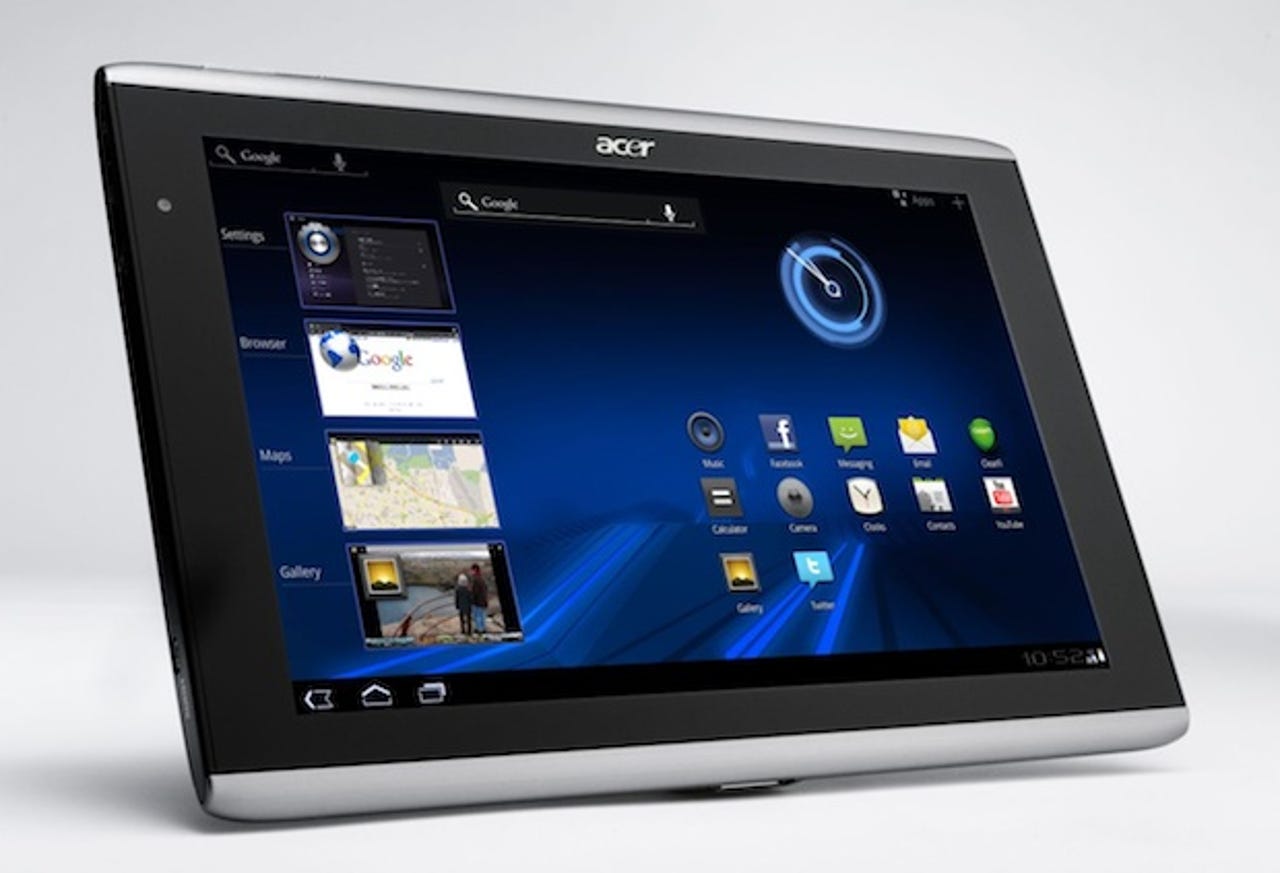Acer Iconia Tab A500


Acer Iconia Tab A500
Acer's Iconia Tab A500 is a 10.1in. Android 3.0 (Honeycomb) tablet that joins the Motorola Xoom, Asus Eee Pad Transformer and Samsung Galaxy Tab 10.1 in a rapidly populating market. The recent Windows 7-based Iconia Tab W500 didn't impress us greatly. Will the very similarly priced A500 (£449.99 inc. VAT; £375 ex. VAT) do any better?
DesignThe Iconia Tab A500 is very nicely made and won't look out of place in either the home or the office. It has a solid feel thanks to aluminum finishing on the long edges and an aluminum backplate. This styling breaks up the look of the front somewhat too, making the screen bezel look thinner than it actually is.
At 700g, the Iconia Tab A500 is relatively heavy compared to other similar-sized tablets — except its Windows 7-based W500 stablemate
The A500's dimensions of 260mm by 177mm by 13.3mm put it in the same ballpark as the Asus Eee Pad Transformer (271 x 171 x 12.98mm), its W500 sibling (275 x 190 x 15.9mm) and Apple's iPad 2 (241 x 185.7 x 8.8mm). It is relatively heavy at 700g — by contrast, the Eee Pad Transformer weighs 680g and the Wi-Fi/3G iPad 2 613g. The Iconia Tab W500 is even heavier at 970g, so perhaps Acer gives weight a different weighting, as it were, to other tablet manufacturers.
Although its weight means that holding the Iconia Tab A500 in one hand becomes a chore after a while, there's no doubt that a 10.1in. screen is far superior to smaller 7in. devices for a wide variety of tasks. The A500's screen has a native resolution of 1,280 by 800 pixels. On its automatic brightness setting it looked a bit dull, and with the manual setting at full brightness it seemed a little washed-out. We were frequently distracted by the screen's reflectiveness, which was especially noticeable when working next to a window. Train travellers in particular might find this a problem. The screen also gets greasy quite quickly from fingerprints and will need regular cleaning. We have no complaints about the viewing angles, which are exemplary. The multitouch touchscreen is responsive, which makes it easy to sweep through the five Android home screens. The automatic screen rotation is smooth too. We mentioned the A500's neat styling. This extends to the small silver lozenge-shaped volume rocker on the top edge and the tiny slider switch next to it that can be used to toggle automatic screen rotation. We found this very useful and would like to see it adopted on more tablets. The A500's good looks are marred by a plastic hinged cover embedded into the aluminum on the top edge of the chassis. This protects a microUSB slot and a SIM card slot. The latter is covered by a 'warranty void if seal is broken' sticker because there's no mobile broadband support in this device. The remainder of the top edge is clear of ports and connectors. The bottom edge houses a single proprietary connector for an optional charging dock. We've not seen a price for this in the UK. The left edge carries the on/off switch, a 3.5mm headset jack and a mini-HDMI port. On the right is a Micro-USB port, a round-pin power connector and a full sized USB port — with USB host capability, so you can attach external devices. We tried a USB stick (which worked) and a mouse, (which didn't). Acer doesn't provide an HDMI cable. At the back is a pair of speakers that deliver tinny but quite loud sound, a lens for the 5-megapixel camera and a small LED flash. There's also a front-facing 2-megapixel camera in the screen bezel, on the left side with the device in landscape mode. The main camera's performance is average, and Acer could probably have done more with it. FeaturesLike the Asus Eee Pad Transformer, the Acer Iconia Tab A500 is powered by an Nvidia Tegra 250 dual-core ARM Cortex-A9 processor, which is accompanied by 1GB of RAM. The A500 currently comes with 32GB of internal storage, but Acer tells us that a 16GB configuration will be available during June costing less than £380 (inc. VAT; £317 ex. VAT). You can augment the internal storage with microSD cards. We've already noted the absence of mobile broadband in our review sample — a second model, the A501, adds this capability and costs £529.99 (inc. VAT; £442 ex. VAT). Wi-Fi (802.11b/g/n) and Bluetooth (2.1+EDR), but not GPS, are present on the Wi-Fi-only review model. The five Android 3.0 home screens are all ready to be populated with a range of widgets designed to take advantage of the tablet's bigger screen. We particularly like scrolling through web bookmark thumbnails, and seeing large widget-based renditions of the calendar and email. Acer adds a few applications to the standard Android bundle, and Nvidia has added its own app store offering games designed to exploit the large screen and dual-core processor. There are a few trial games on-board too. Among Acer's additions are SocialJogger, which brings together Twitter and Facebook contacts; a media server for sharing photos, videos and music via DLNA; LumiRead for ebook management; NemoPlayer for playing audio, video and image viewing; ClearFi, for the same purpose; Photo Browser 3D for flipping through the photo library using the motion sensors; and a trial version of Aupeo, an internet radio app. There's nothing here we've not seen before, and some people will find the duplication of multimedia services both confusing and irritating. Acer also adds what it calls 'zones' into which you can group apps — there are multimedia, social, eReading and game zones. The visual metaphor is a set of shelves with icons representing your apps. We didn't take to it, but it's easily ignored. The inclusion of Documents To Go is welcome, but sadly it's for document viewing only — you'll need to pay to get editing and creation facilities. Battery life
Acer rates the 3,260mAh Li-polymer battery as good for 10 hours of web surfing on the Wi-Fi-only model, or 8 hours of video playback. We didn't have the Iconia Tab A500 for long enough to perform rigorous battery tests, but we reckon it'll be good for around 6 hours of continuous video playback from internal memory. It should get you through a weekend away from mains power unless you're a particularly heavy user. Conclusion
Acer is already up against stiff competition in the Android tablet market, in the shape of the Asus Eee Pad Transformer. Given that the Eee Pad Transformer with a docking keyboard costs roughly the same as the tablet-only Icona Tab A500, we'd probably choose the Asus product at this time. But it's early days for this market, and there's lots of competition on the way.